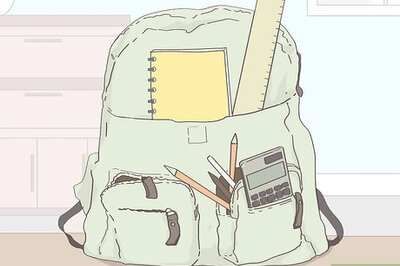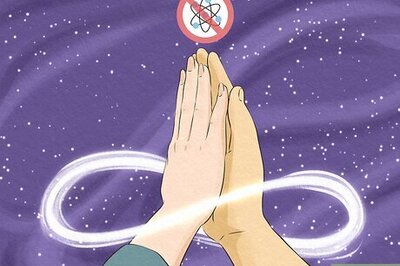
views
Your 500 and 1,000 rupee notes will be worthless bits of paper this morning. But don’t panic! You won’t lose out if you follow these instructions from the Reserve Bank of India.
1. What is this scheme?
The legal tender character of the notes in denominations of ₹ 500 and ₹ 1000 stands withdrawn. The withdrawn old high denomination (OHD) notes cannot be used for transacting business or as a store of value. The OHD notes can be exchanged for value at any of the 19 offices of the Reserve Bank of India, any bank branch or head post office/sub-post office.
2. How much value will I get?
You will get the entire value for the volume of old notes exchanged.
3. Can I get all in cash?
No. You will get upto ₹4000 per person in cash irrespective of the size of tender and anything over and above that will be credited to your bank account.
4. ₹4000 cash is insufficient for my needs. What do I do?
You can use the balance in your bank accounts to pay for other requirements by cheque or through electronic means of payment such as internet banking, mobile wallets, IMPS, credit/debit cards etc.
5. I don’t have a bank account?
You can always open a bank account with the necessary documents for fulfilling the KYC requirements.
6. Where can I exchange the notes?
The exchange facility is available at all issue offices of the RBI and commercial banks/RRBS/UCBs/State Co-op banks or at any head post office or sub-post office.
7. Do I need to go to my bank branch only?
For exchange upto 4000 in cash you may go to any bank branch with valid identity proof. For exchange over 4000, which will be credited to the bank account, you have to go to the branch where you have an account or to any branch of the same bank. In case you go to a branch of any other bank where you don’t have an account, you will have to furnish valid identity proof and bank account details for an electronic fund transfer to your account.
8. I have no account but my relative/friend has an account, can I get my notes exchanged into that account?
Yes, you can, if the relative/friend gives you written permission. You should provide the bank the written authorization and a valid identity proof.
9. Should I go to the bank personally or can I send the notes through my representative?
A personal visit to the branch is preferable. In case it is not possible you may send your representative with written authorization and a valid identity proof while tendering the notes.
10. Can I withdraw from ATM?
It may take a while for the banks to recalibrate their ATMs. Once the ATMs are functional, you can withdraw from ATMs upto a maximum of ₹2,000/- per card per day upto 18th November, 2016. The limit will be raised to ₹4000/- per day per card from 19th November 2016 onwards.
11. Can I withdraw cash against cheque?
Yes, you can withdraw cash against withdrawal slip or cheque subject to a ceiling of ₹10,000/- per day within an overall limit of ₹20,000/- in a week (including withdrawals from ATMs) for the first fortnight i.e. upto 24th November 2016.
12. Can I deposit withdrawn notes through ATMs, cash deposit ma
chine or cash recycler?
Yes, demonetized notes can be deposited in cash deposit machines/cash recyclers.
13. Can I make use of electronic (NEFT/RTGS /IMPS/Internet Banking/Mobile banking) mode?
You can use NEFT/RTGS/IMPS/Internet Banking/Mobile Banking or any other electronic/non-cash mode of payment.
14. How much time do I have to exchange the notes?
The scheme closes on 30th December 2016. The demonetized banknotes can be exchanged at commercial bank branches, regional rural banks, urban cooperative banks, state cooperative banks and RBI till 30th December 2016. For those who are unable to exchange their Old High Denomination Banknotes on or before December 30, 2016, an opportunity will be given to them to do so at specified offices of the RBI.
15. I am right now not in India, what should I do?
If you have the demonetized banknotes in India, you may authorize in writing enabling a person in India to deposit the notes into your bank account. The person so authorized has to come to the bank branch with the demonetized banknotes, the authority letter given by you and a valid identity proof.
16. I am an NRI and hold an NRO account, can the exchange value be deposited in my account?
Yes, you can deposit the demonetized banknotes to your NRO account.
17. I am a foreign tourist, who has demonetized notes. What should I do?
You can purchase foreign exchange equivalent to ₹5000 using the demonetized notes at airport exchange counters within 72 hours after the notification, provided you present proof of purchasing the demonetized notes.
18. I have emergency needs (hospitalisation, travel, life saving medicines) that require cash, what do I do?
You can use the demonetized notes for payment at government hospitals, purchasing bus tickets at government bus stands for travel by state government buses, train tickets at railway stations, and air tickets at airports within 72 hours after the notification.
19. What is valid proof of identity?
Any of the following: Aadhaar Card, Driving License, Voter ID Card, Pass Port, NREGA Card, PAN Card, Identity Card Issued by government departments or Public Sector Units to its Staff.
20. Where can I get more information on this scheme?
Further information is available on www.rbi.org.in or call the control room of RBI on Telephone Numbers 022-22602201 and 022-22602944

















Comments
0 comment